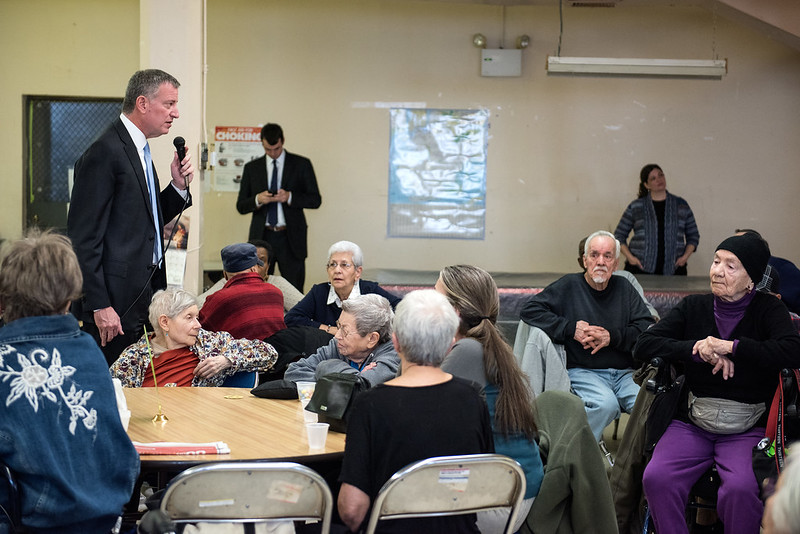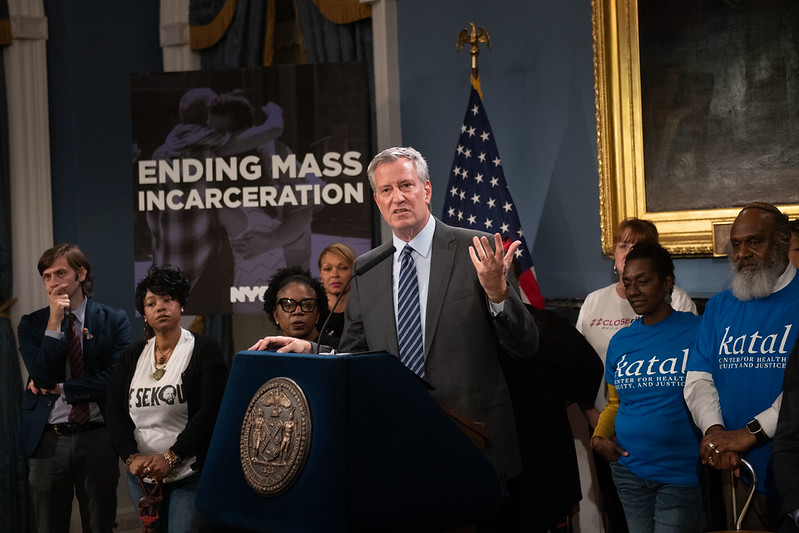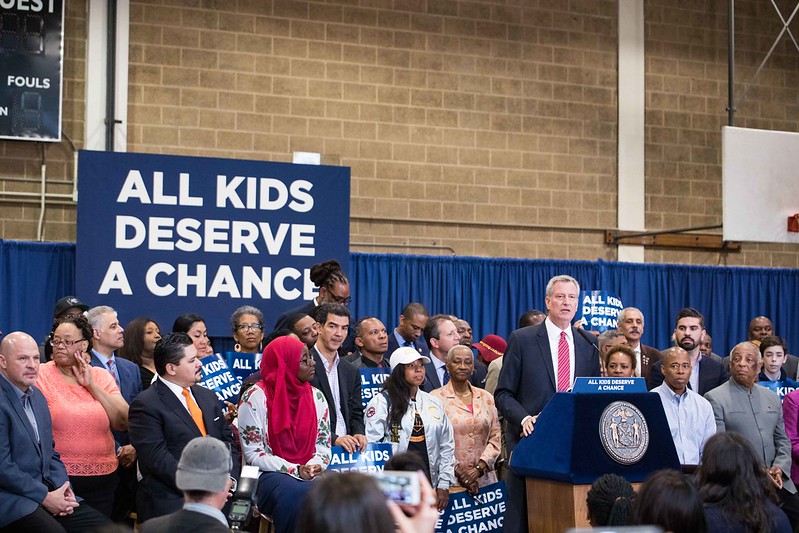City Threatens to Exacerbate Affordable Housing Crisis for New York Seniors

Mayor de Blasio talks with seniors (photo: Demetrius Freeman/Mayor's Office)
For far too long, older adults in New York City have been struggling to find a safe and affordable place to call home. The pandemic has exacerbated these challenges and exacerbated an affordable housing emergency that’s especially dangerous for populations including New York’s low-income seniors. As we look to recover, we need to prioritize the sustained production of affordable housing, particularly as a way to stabilize and support our older residents now and in the future.
Older New Yorkers were struggling to make rent even before the pandemic hit. More than one-quarter (27 percent) of New York’s renters are 60 or older, the highest share in the country. Nearly one in seven seniors in the city live in poverty, according to a report from the Center for an Urban Future, and more than 200,000 seniors are on a waiting list for the Department of Housing and Urban Development’s (HUD) Section 202 program, according to LiveOn NY.
In fact, demographic data suggests that the senior population in the five boroughs will increase 50 percent by 2040. The need for quality, safe, and affordable housing for seniors will become more vital as our city continues to age.
Unfortunately, the latest capital budget proposed by the de Blasio administration misses the mark in this regard. The budget would cut funding to the Department of Housing Preservation and Development (HPD) by 40 percent, resulting in a loss of up to 21,000 of affordable units over the next two years, according to a recent study from the New York Housing Conference.
There is a shadow of doubt over the entire pipeline and it is older New Yorkers that will be left behind. It is vital that the city fund, develop, and finish projects designed specifically to address seniors. For example, a project in the proposal stage in Astoria that would provide deeply affordable homes to New Yorkers over the age of 62 but may now be significantly delayed or even halted entirely.
This is just one example of many projects designed to address this growing need and the loss is incalculable for New Yorkers that need these homes now. New York City’s aging population is depending on our elected officials to make smart policy decisions that will protect them, especially during these unprecedented times. City Hall must reverse the budget cut and commit to provide critical funding for lifelong New Yorkers in their most vulnerable years.
In fact, prioritizing affordable housing development will help pave the way toward economic recovery. A NYSAFAH study found that a 100-unit affordable housing development in New York typically generates nearly 200 construction jobs and 20 permanent jobs. Additionally, the development would result in an average of nearly $30 million in economic spending during construction and over $3.5 million in sustained local economic activity.
In other words, investment in affordable housing not only addresses critical needs, it generates critical economic activity. It’s win-win every time.
Fully funding HPD’s capital budget is the sort of low-risk policy proposal that will pay dividends in both the short- and long-term. It is exactly what we need right now – and it will remind elderly New Yorkers that their elected officials have their best interests at heart.
***
Jolie Milstein is the president and CEO of the New York State Association for Affordable Housing. Allison Nickerson is the Executive Director of LiveOn NY. Karen Haycox is CEO of Habitat for Humanity NYC and President of the Habitat NYC Community Loan Fund. On Twitter @NYSAFAH & @liveonny & @HabitatNYC.
***
Have an op-ed idea or submission for Gotham Gazette? Email This email address is being protected from spambots. You need JavaScript enabled to view it.
Defund the DOC, Invest in Supportive Housing

Mayor de Blasio discussing jails (photo: Michael Appleton/Mayor's Office)
Michael Tyson, Raymond Rivera, Layleen Polanco, Wayne Henderson, Kalief Browder, Jerome Murdough, Bradley Ballard, Carlos Mercado, Ronald Spear. Just some of the Black and brown people who have died in recent years from neglect or abuse at Rikers Island. As our city and country demand justice for racial inequities in policing and beyond, the budget for New York City’s brutally violent, racially unjust, fiscally unjustifiable Department of Correction must be cut. The savings should be redirected to programs proven to keep people out of jail and advance safety, through a combination of housing and wrap-around services.
Imagine that you are locked up, punished without having been convicted, in a sweltering cage in one of the nine jails on Rikers Island. Imagine that your economic security has been destroyed and your family relationships ripped apart based on an accusation. This disproportionately happens to Black and Latino people, who are not afforded the same opportunities of innocence until proven guilty.
We make up 88 percent of the people incarcerated in New York City jails. We experience the extreme violence of Rikers, which is at an all-time high. We are isolated at Rikers from families, attorneys, and service providers. We fail to receive mental health care and other needed services.
Even if you believe in incarceration as punishment and incapacitation, Rikers is much more than that: it is unequitable, unconstitutional, and unfathomably expensive.
This year, New York City is spending $2.5 billion to jail people, amounting to more than $400,000 per person per year.
With the city’s jail population at a low unseen since World War II, we can save hundreds of millions from the DOC budget by continuing a hiring freeze, cutting jail riot squads that a federal court’s monitor found exacerbate violence, greatly reducing overtime, and continuing to close sparsely-populated jails. Then we can multiply those savings by broadening the scope of and resolutely funding far cheaper alternatives to Rikers that we know work better.
A key element: provide housing when needed. Since 2017, the Women’s Community Justice Project has provided housing and services to homeless women jailed at Rikers pending trial for a wide range of alleged crimes. Of over 200 women served—the majority of whom are mothers and caregivers, often battling mental illness and substance use—98 percent made all court appearances and only two were charged with new crimes. The average cost: $30,000 per person per year, 1/13 the cost of Rikers.
In March 2020, to alleviate the close confinement that was causing coronavirus to spread in New York City jails at nine times the rate of the rest of the city, the DOC released 312 people who had been sentenced to less than a year in jail. Many had long histories of homelessness, serious mental illness, and substance use. Some were effectively doing life sentences one misdemeanor conviction at a time, demonstrating that repeatedly jailing them had failed them – and us.
For a fraction of the cost of Rikers, the city traded the brutality and degradation of Rikers for emergency housing and wrap-around services offered by Exodus Transitional Community and other non-profits. People have been connected to social services, treatment, jobs, and long-term housing at rates previously unseen. Only one program participant has been re-arrested for a serious violent offense. These results speak for themselves.
The remaining savings should be a down-payment on community-led investments in Black and brown neighborhoods ravaged by COVID-19 and long harmed by Rikers.
We also urge City Hall to press forward with the much smaller borough jails needed to end Rikers. Every month of delay condemns thousands of Black and brown people to continued abuse and mistreatment at Rikers. Construction will also generate thousands of critically-needed, good-paying jobs. To keep on schedule, we need to spend only enough this year to allow the planning process to proceed and begin to demolish the decrepit jail in downtown Brooklyn.
We can work together to end the glaring racial inequities and inequalities in our city’s criminal justice system, embodied in the Department of Correction and Rikers Island. These institutions have inexcusably harmed Black and brown people for decades. By cutting DOC’s budget and investing in housing and services, we can advance racial justice, economic sense, and safer streets. This is a no-brainer.
***
Dr. Alethea Taylor is the former Executive Director of Greenhope Services for Women, Inc. Julio Medina is founder, executive director, and CEO of Exodus Transitional Community.
***
Have an op-ed idea or submission for Gotham Gazette? Email This email address is being protected from spambots. You need JavaScript enabled to view it.
How We Must Reinvent New York City Education After Coronavirus

(photo: Benjamin Kanter/Mayoral Photo Office)
It’s 8:30 a.m. on a Tuesday. My youngest, now 13, needs help setting up for the Zoom meeting I wrangled with his math teacher so they can address how his dyscalculia is making fractions difficult. My middle child has just roused, a mark of my hard-earned success in resetting her circadian rhythm disrupted by these strange times. My eldest wants to discuss whether she should take “no-grade” on one of her courses during her second semester in college—the transition to remote learning at home has been too rocky for her to maintain focus on each course.
My home is a microcosm for how COVID-19 has turned education upside down. This disruption hits even harder for single-parent homes, families with students who have learning disorders or disabilities, and multi-generational families like mine. Like tens of thousands of other parents, I’m focused on how we can make things better for us and our kids.
I know these things from a professional perspective, too. For over a decade I have fought for equitable school funding, increased capacity for quality child care, for better access to dyslexia diagnostic services and support especially in low-income communities, and against the emphasis on testing in public education.
We need a systematic reimagining of public education, and what better time than now. But that phrase has been bandied about a lot recently by some people with pretty different ideas than mine. I’m never going to go along with billionaires “redesigning” public schools—that experiment over the past 20 years did more harm than good. When I say reimagine, here’s what I mean.
We need to focus our school communities on healing from the traumas of COVID-19 and racism. Schools in working-class neighborhoods and neighborhoods of color were already at a disadvantage before the crisis in terms of funding and access to resources. These neighborhoods also have been some of the hardest hit by the virus.
This is a pivotal moment in our history. If we believe Black lives matter, how do we turn that philosophy into reality for today’s students? Now is the time to rethink our approach to school culture—get rid of the metal detectors, train school communities in restorative justice, and institute a comprehensive social-emotional learning curriculum developed with high-trauma populations in mind.
Much of this work starts before children even enter a classroom. Our interventions must start with universal child care—including subsidies for families, increased capacity for infant and toddler care, and pay parity for child-care providers and early childhood teachers. The cost of child care for more than one child can rival the cost of paying rent. This is especially crippling for single mothers. When it comes to 3K, pre-K, and kindergarten, we should listen to the experts who highlight the importance of play-centered education.
Throughout our children’s education, we also must commit to curricular best practices that move us away from high-stakes testing. The state tests were canceled for COVID-19 this year, as were the Regents Exams, and no student will be the worse for it.
We need to adopt holistic evaluation methods like portfolio reviews that meet the needs and measure the growth of all students where they are. These changes are especially important for multilingual learners and students with learning disorders or disabilities, whom high-stakes testing harms the most.
Such curricular best practices include culturally-responsive education that builds on students’ experiences in the world. Likewise, the power of movement must be recognized in providing physical education as already mandated by the state but too often not provided. Expression through the arts cannot be just a luxury afforded to the wealthiest schools, not when we know how transformative and healing these practices can be for our kids.
Spending less time on testing will make it possible to offer courses our students will need for life outside high school like civics and financial literacy. It will also help us shift the focus to emphasize the interpersonal skills that will prepare our students to thrive in careers of social work, health care, education, and other low-carbon work we will need more of as we face the defining challenge we are passing on to the next generations, the climate crisis.
We will also need to reduce class sizes. The kind of attention our students need coming out of this crisis necessitates a lower student-to-teacher ratio. The current average class size of 24 for K–3 classrooms and almost 27 for grades 4–8 are far too high, and unconscionable in the wake of COVID-19. For our students to re-engage with learning when they go back to school buildings, we need to have smaller class sizes. Teachers are the primary support for our students, and they must be given the time to focus on the individual growth areas of each student.
As those of us working from home have seen in our own remote work, technology can indeed be a powerful tool for connection. But the flip side is privacy, especially when it comes to our children. As privatizing forces move in post-coronavirus to “reimagine” education through technological solutions, we need to draw hard and fast lines to protect the privacy of each member of our school communities. Data privacy can’t be an afterthought; it has to be baked in at the outset. It’s another reason to keep billionaires and giant tech companies out of our schools.
All of these policy ideas already exist in well-researched, ready-to-execute forms. What we have lacked is the political will to make them happen at scale.
Now is our chance. In this upcoming New York City budget, due in just a few days, we have to reject austerity. We must surgically defund the NYPD budget not just to preserve but to grow our spending on these crucial policy initiatives like smaller class sizes and retooling school culture. At the same time, we need to consolidate administrative sprawl within the Department of Education so our response to the traumas of COVID-19 can be swift and more effective for our students.
The City Council has an opportunity to step up to the plate for our children, and with 41 of them term-limited out at the end of 2021, it’s their chance to leave an impressive legacy of support for our students when they need it the most.
***
Johanna Garcia is a chief of staff in the New York State Senate, a former president of Community Education Council District 6, and a candidate for City Council in Manhattan’s 10th District. On Twitter @JohannaG_NYC.
***
Have an op-ed idea or submission for Gotham Gazette? Email This email address is being protected from spambots. You need JavaScript enabled to view it.




